| Heliolonche | |
|---|---|
 | |
| Scientific classification | |
| Domain: | Eukaryota |
| Kingdom: | Animalia |
| Phylum: | Arthropoda |
| Class: | Insecta |
| Order: | Lepidoptera |
| Superfamily: | Noctuoidea |
| Family: | Noctuidae |
| Subfamily: | Heliothinae |
| Genus: | Heliolonche Grote, 1873 |
| Synonyms [1] | |
| |
| Heliolonche | |
|---|---|
 | |
| Scientific classification | |
| Domain: | Eukaryota |
| Kingdom: | Animalia |
| Phylum: | Arthropoda |
| Class: | Insecta |
| Order: | Lepidoptera |
| Superfamily: | Noctuoidea |
| Family: | Noctuidae |
| Subfamily: | Heliothinae |
| Genus: | Heliolonche Grote, 1873 |
| Synonyms [1] | |
| |

Acronicta is a genus of noctuid moths containing about 150 species distributed mainly in the temperate Holarctic, with some in adjacent subtropical regions. The genus was erected by Carl Linnaeus in his 1758 10th edition of Systema Naturae. Caterpillars of most Acronicta species are unmistakable, with brightly colored hairy spikes, and often feed quite visibly on common foliate trees. The hairy spikes may contain poison, which cause itchy, painful, swollen rash in humans on contact. The larva of the smeared dagger moth is unusually hairy even for this genus. Acronicta species are generally known as dagger moths, as most have one or more black dagger-shaped markings on their forewing uppersides. But some species have a conspicuous dark ring marking instead.

Pyrausta is a speciose genus of moths of the family Crambidae. The genus was erected by Franz von Paula Schrank in 1802.
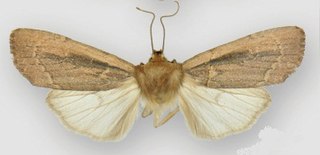
Ufeus is a genus of moths of the family Noctuidae.

Anarta is a genus of moths in the family Noctuidae.
Axenus is a monotypic moth genus of the family Noctuidae. Its only species, Axenus arvalis, is found in the US states of California and Oregon. Both the genus and species were first described by Augustus Radcliffe Grote in 1873.

Annaphila is a genus of moths of the family Noctuidae. The genus was erected by Augustus Radcliffe Grote in 1873.
Bellura is a genus of moths of the family Noctuidae.

Zanclognatha is a genus of litter moths of the family Erebidae. The genus was erected by Julius Lederer in 1857.

Euxoa is a genus of moths of the family Noctuidae raised to Genus by the German entomologist, Jacob Hübner. The Genus is mostly confined to dry and semi dry areas in the Northern Hemisphere. There 130 species in Eurasia, a few in Africa, and 175 in North America. There are no species in the Genus in South-East Asia or in Australia. In North America, most species are found in Western regions. Of the North American species, 4 are endemic to Mexico. There is one species recorded from Chile, but this may be a mislabeled specimen. In real terms, species numbers do not equal species abundance. Some areas with few species have large numbers of the ones that do live there.
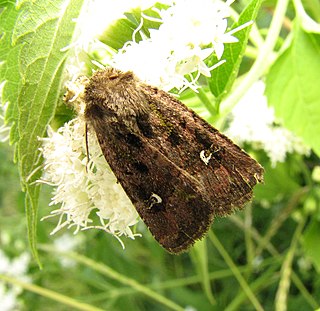
Lacinipolia is a moth genus in the family Noctuidae.

Oxycilla is a genus of moths in the family Erebidae. The genus was erected by Augustus Radcliffe Grote in 1896.

Phalaenostola is a genus of litter moths of the family Erebidae. The genus was erected by Augustus Radcliffe Grote in 1873.

Plagiomimicus is a genus of moths of the family Noctuidae. The genus was erected by Augustus Radcliffe Grote in 1873.
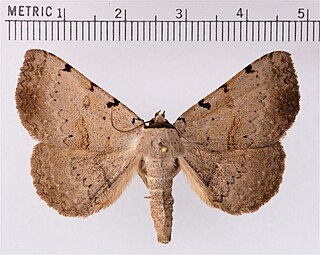
Spiloloma is a monotypic moth genus in the family Erebidae. Its only species, Spiloloma lunilinea, the moon-lined moth, is found in eastern and south-central North America. Both the genus and species were first described by Augustus Radcliffe Grote in 1873.
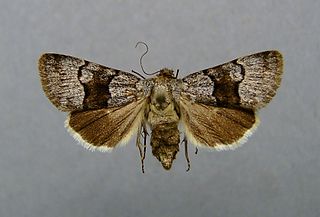
Sympistis is a genus of moths of the family Noctuidae. The genus was erected by Jacob Hübner in 1823.

Tetanolita is a genus of litter moths of the family Erebidae. The genus was erected by Augustus Radcliffe Grote in 1873.

Digrammia was a genus of moths in the family Geometridae erected by Carl Freiherr von Gumppenberg in 1887. It is now often considered a synonym of Semiothisa.

Heliothinae is a small, cosmopolitan subfamily of moths in the family Noctuidae, with about 400 described species worldwide. It includes a number of economically significant agricultural pest species, such as Helicoverpa armigera and Helicoverpa zea.

Spargaloma is a monotypic moth genus in the family Erebidae. Its only species is Spargaloma sexpunctata, the six-spotted gray. Both the genus and species were first described by Augustus Radcliffe Grote in 1873. It is found from coast to coast in lower Canada south in the east to Florida, Mississippi and Arkansas, in the west to California.
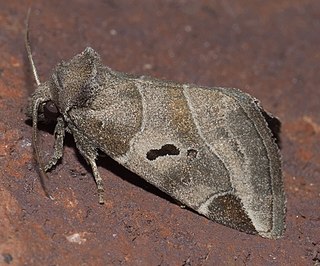
Stiriinae is a subfamily of owlet moths in the family Noctuidae. There are more than 20 genera and 130 described species in Stiriinae.